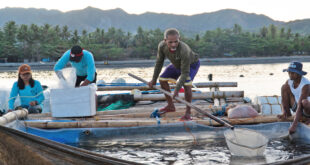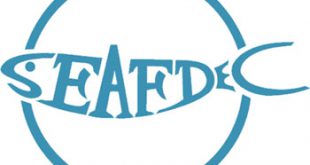 Technology description
Technology description
Although the technology applies to all three species of mud crab (Scylla serrata, S. tranquebarica, S. olivacea), S. serrata or giant/king crab has been the focus of culture due to its economic viability. Healthy mature crabs with complete limbs are chosen as breeders. The crabs are maintained in the tank until they spawn (release of eggs). After hatching of eggs, care is taken to raise the zoea to the megalopa stage in the hatchery. Feed used are Brachionus and Artemia. Water replacement may be from 30 to 80% every 5 days. Megalopae are then transferred to nursery tanks or net cages before they can be stocked in ponds or pens, and are fed mollusks or fish. Hatchery and nursery can take 52-55 days.
| Technology profile: | |
 (1) Gather several female crabs with fully mature ovaries (orange ovaries), at least ≥500 g or 12.5 mm carapace width for S. serrata; 320 g or 12.2 mm S. tranquebarica; 320 g or 11.5 mm S. olivacea. (2) Acclimate by pouring water over the crabs in a basin every 5 minutes for about 30 min. Transfer crabs to a basin containing 150 ppm formalin for another 30 min to disinfect before stocking in aerated broodstock tanks. (3) After allowing crabs to recover from handling and transport stress, ablate one eyestalk of immature crabs (with yellow ovaries) using a sterilized blade to incise and a red-hot forceps to clip off. Apply terramycin ointment to the wound. Allow crab to recover in a small volume of seawater (so as not to wet its wound) before putting back to broodstock tank. Cover the tank. (4) Crabs spawn within 2-4 weeks. To care for berried crabs (females with eggs attached to the abdominal flap), feed them mussel, fish or marine worms at 10-15% of biomass daily. (5) Remove uneaten food and feces daily. Discontinue feeding after 5-6 days or when the egg mass turn brown. Change 50- 80% of water volume daily. S. serrata produce 0.8 to 5 million zoeae per spawning; S. tranquebarica between 0.7 to 3 million; and S. olivacea between 0.4 to 2.7 million. (6) Collect zoeae within an hour of its appearance to prevent microbial attack. Stock in larval rearing tanks at 50-80 zoeae per liter. Feed with rotifers, maintaining a density of 10-15 Brachionus per ml in the first 10 days. Give newly hatched Artemia in the late zoea stage (0.5-1 per ml), and larger ones in the megalopa stage (feed to satiation twice daily). Maintain good water quality. (7) Transfer megalopae to bigger tanks or net cages after about 21 days. Stock at 1-2 per liter in 10-ton tanks, or 50-70 per sq. m in cages. Feed 5-7-day-old Artemia, later adding minced trash fish, small (8) About 52 days from hatching, the crab juveniles can be harvested, packed and transported to ponds or pens for grow-out culture. |
|
References:
Catacutan MR. 2002. Growth and body composition of juvenile mud crab Scylla serrata, fed different dietary protein and lipid levels and protein to energy ratios. Aquaculture 208:113-123
Catacutan MR, Eusebio PS, Teshima S. 2003. Apparent digestibility of selected feedstuffs by mud crab, Scylla serrata. Aquaculture 216: 253-261
Lavilla-Pitogo CR, de la Pena LD. 2004. Diseases in farmed mud crabs Scylla spp.: diagnosis, prevention and control. SEAFDEC Aquaculture Department, Tigbauan, Iloilo. 89 p.
Lavilla-Pitogo CR, Marcial HS, Pedrajas SAG, Quinitio ET, Millamena OM. 2001. Problems associated with tank-held mud crab (Scylla spp.) broodstock. Asian Fisheries Science 14:217-224
Leaño EM. 2002. Haliphthoros spp. from spawned eggs of captive mud crab, Scylla serrata, broodstocks. Fungal Diversity 9:93-103
Millamena OM, Quinitio ET. 2000. The effects of diets on reproductive performance of eyestalk ablated and intact mud crab Scylla serrata. Aquaculture 181:81-90
Quinitio ET, Estepa FD. 2003. Biology and hatchery of mud crabs Scylla spp. Aquaculture Extension Manual 34, SEAFDEC Aquaculture Department, Tigbauan, Iloilo. 42 p
Quinitio ET, Parado-Estepa FD. 2000. Transport of Scylla serrata megalopae at various densities and durations. Aquaculture 185:63-71
Quinitio ET, Parado-Estepa FD. 2001. Simulated transport of Scylla serrata zoeae at various loading densities. Asian Fisheries Science 14:225-230
Quinitio ET, Parado-Estepa FD, Millamena OM, Rodriguez EM. 2001. Seed production of mud crab Scylla serrata juveniles. Asian Fisheries Science 14:161-174
Peñaflorida YD. 2004. Amino acid profiles in the midgut, ovary, developing eggs and zoea of the mud crab, Scylla serrata. Israeli Journal of Aquaculture – Bamidgeh 56:113-125
 SEAFDEC/AQD Southeast Asian Fisheries Development Center | Aquaculture Department
SEAFDEC/AQD Southeast Asian Fisheries Development Center | Aquaculture Department



